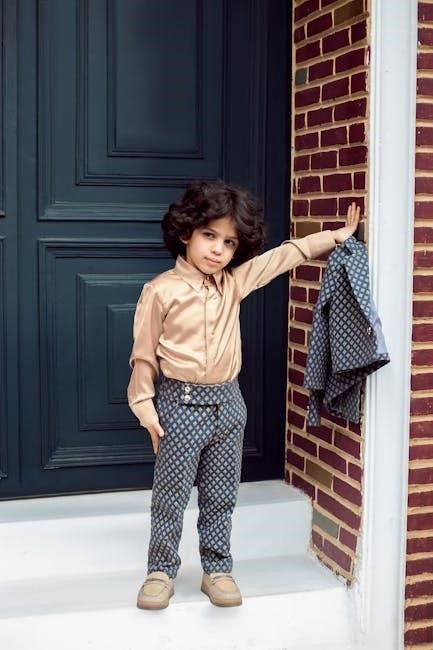The Birkenstock US Size Guide is a comprehensive resource for understanding European sizing standards in US measurements. This guide helps you find the perfect fit by converting European sizes to US equivalents, ensuring comfort and the right style for your needs. It covers conversion charts, popular styles, and maintenance tips to keep your Birkenstocks comfortable for years.
Understanding the Importance of Proper Sizing
Proper sizing is crucial for comfort and support in Birkenstock footwear. Ill-fitting shoes can lead to discomfort, foot fatigue, and even long-term foot health issues. Birkenstocks are designed with contoured footbeds to provide excellent arch support and cushioning, but these benefits are only fully realized with the correct fit. Improper sizing can result in poor alignment, reduced stability, and an increased risk of blisters or calluses. By understanding the size guide, you can ensure a snug yet comfortable fit, allowing your feet to breathe and move naturally. This is especially important for people with specific foot shapes or arch types.
Brief Overview of Birkenstock’s Sizing System
Birkenstock’s sizing system is based on European standards, which differ from US sizing. This means that direct size comparisons require conversion. The system includes a range of sizes for both men and women, with options for different widths—narrow, regular, and wide—to accommodate various foot shapes. The sizing chart typically includes numerical sizes, often in increments of half sizes, ensuring a more precise fit. Additionally, Birkenstock offers a contoured footbed design, which is shaped to support the natural curves of the foot. Understanding this system is essential for selecting the right size and width to ensure comfort and proper support.

Understanding Birkenstock Sizing Standards
Birkenstock sizing follows European standards, requiring US conversion, offering narrow, regular, and wide widths, and featuring contoured footbeds for enhanced comfort and proper support.
European vs. US Sizing: Key Differences
The primary difference between European and US sizing lies in measurement standards, with European sizes based on foot length in centimeters. Unlike US sizing, which varies by brand, European sizes are more uniform. For instance, a US size 7 may correspond to a European size 37 or 38, depending on the brand. This discrepancy often leads to fitting challenges for those accustomed to US measurements. Birkenstock, using European sizing, emphasizes the importance of accurate conversion to ensure comfort and proper fit. Additionally, European sizes include width options, further distinguishing them from US sizing, which often lacks such specificity.
How Birkenstock Sizes Compare to Other Brands
Birkenstock sizes differ from other brands due to their European sizing system, which is more standardized. While many brands use varying fit models, Birkenstock adheres to consistent measurements, making size conversions more precise. This can sometimes confuse shoppers accustomed to US sizing. Birkenstock’s focus on foot health, with features like contoured footbeds, also sets them apart. Other brands may prioritize fashion over fit, whereas Birkenstock emphasizes comfort and support. This unique approach means their sizing may not align directly with what you’re used to, making it essential to consult their size chart for accuracy. Understanding these differences ensures the best fit for your needs.
Birkenstock US Size Guide for Men
The Birkenstock US Size Guide for Men provides accurate European to US size conversions, ensuring a perfect fit. Popular styles like Arizona and Boston offer roomy toe boxes for comfort, while contoured footbeds support all-day wear. This guide helps men choose the right size, balancing style and comfort seamlessly.
Men’s Size Chart: US to European Conversion
Birkenstock’s US to European size conversion chart for men ensures accurate fit. US sizes range from 7 to 16, corresponding to European sizes 40 to 50. For example, a US size 8 equals a European 41, while a US 10 corresponds to a European 43. This chart helps men select the correct size, avoiding the guesswork of international sizing differences. By aligning US and European measurements, Birkenstock makes it easy to find the perfect fit. Understanding this conversion is key to enjoying the comfort and durability of Birkenstock footwear. Always refer to the official size guide for precise measurements.
Popular Men’s Styles and Their Fit Characteristics
Popular Birkenstock men’s styles include the Arizona, Boston, and Gizeh. The Arizona is a classic two-strap sandal, offering a relaxed fit with adjustable straps. The Boston clog features a one-piece upper and a roomy toe box, ideal for casual wear. The Gizeh, a thong sandal, provides a secure fit with a contoured footbed. Each style caters to different foot shapes and preferences, ensuring comfort and support. Understanding the fit characteristics of each model helps men choose the perfect pair for their lifestyle. Whether for everyday use or outdoor activities, Birkenstock’s designs prioritize comfort and durability, making them a favorite among men worldwide.

Birkenstock US Size Guide for Women
This section provides a detailed guide for women, helping them find the perfect fit by converting European sizes to US equivalents. It ensures comfort, support, and style.
Women’s Size Chart: US to European Conversion
The Women’s Size Chart provides a clear US to European size conversion, ensuring a perfect fit. US women’s sizes range from 4 to 14, corresponding to European sizes 35 to 45. This chart helps women match their US size to the equivalent European size, avoiding sizing confusion. By aligning US and European standards, it guarantees comfort and the right fit. The chart is essential for online shoppers and in-store buyers, offering a precise guide for selecting the correct size. This conversion ensures that every woman can enjoy the comfort and support Birkenstock is known for, regardless of the sizing system.
Popular Women’s Styles and Their Fit Characteristics
Birkenstock offers a variety of popular women’s styles, each with unique fit characteristics. The Gizeh is a thong sandal with a contoured footbed, ideal for warm weather. The Arizona features two adjustable straps, providing excellent support and a customizable fit. The Mayari is a toe-ring sandal with a sleek design and soft footbed for comfort. The Madrid is a backless sandal with a minimalist look, while the Flor offers a delicate, flower-inspired strap. Each style caters to different foot shapes and preferences, ensuring a comfortable and stylish fit for every woman. These styles are popular for their durability and ergonomic design.

Birkenstock US Size Guide for Kids
Birkenstock offers a Kids’ US Size Guide to ensure proper fit and comfort for growing feet. This guide includes size conversions and measurement tips to help parents find the best fit for their children, ensuring optimal support and comfort. Popular styles like the Kid’s Arizona and Kid’s Gizeh are known for their durability and adjustable straps, making them ideal for active kids. The guide also highlights how foot shape and growth impact sizing, helping parents make informed decisions for their children’s footwear needs.
Kids’ Size Chart: US to European Conversion
The Birkenstock Kids’ Size Chart provides a clear US to European size conversion, ensuring a perfect fit for children. The chart ranges from US Toddler sizes, such as 8-9 (equivalent to EU 25-26), up to US Youth sizes, like 6 (EU 39). It includes detailed measurements to help parents determine the correct size based on their child’s foot length. The guide also notes that Birkenstock’s contoured footbed and adjustable straps offer excellent support and comfort for growing feet. By using the chart, parents can ensure their kids enjoy the benefits of Birkenstock’s quality and comfort, with sizes tailored to fit various foot shapes and growth stages.
Popular Kids’ Styles and Their Fit Characteristics
Birkenstock offers several popular styles for kids, each designed to provide comfort and support. The Kid’s Arizona features two adjustable straps, offering a secure fit, while the Kid’s Gizeh includes a single strap with a toe ring for added stability. Both styles have a contoured footbed that cradles the foot, promoting healthy arch support. The soft, cushioned footbed is ideal for growing feet, and the adjustable straps ensure a customizable fit. These styles are lightweight and durable, making them perfect for active children. They also accommodate various foot shapes, ensuring long-lasting comfort and support for kids throughout the day.

Understanding Width Options
Birkenstock offers Narrow, Regular, and Wide widths to accommodate different foot shapes. These options ensure a comfortable fit, with the Regular being the most common choice for everyday wear.
Narrow, Regular, and Wide Widths Explained
Birkenstock offers three width options: Narrow, Regular, and Wide. The Narrow width is ideal for slimmer feet or those with higher arches, providing a snug fit. The Regular width suits most foot shapes, offering a balanced fit for everyday wear. The Wide width accommodates broader feet or individuals who prefer extra room for comfort. Each width ensures proper support and alignment, reducing discomfort and preventing issues like blisters or overcrowding. Understanding your foot shape and width needs is crucial for selecting the right size and style, ensuring long-lasting comfort and satisfaction with your Birkenstock footwear.
How to Choose the Right Width for Your Foot
Selecting the correct width for your Birkenstock is essential for optimal comfort and support. Start by measuring your foot width using a Brannock device or tracing your foot on paper. If your foot is narrower than average, opt for the Narrow width. For most foot shapes, the Regular width provides a balanced fit. Those with broader feet or who prefer extra space should choose the Wide option. Consider how your foot feels when walking—there should be no pressure or slipping. Proper width ensures proper alignment, preventing discomfort and extending the life of your Birkenstock. Always try shoes on if possible for the best fit.

How to Measure Your Foot for Birkenstock
Measure your foot by placing it flat on a surface, aligning the heel with a straight edge. Use a ruler or Brannock device to ensure an accurate fit and proper alignment for optimal comfort in Birkenstock footwear.
Step-by-Step Guide to Accurate Measurement
- Place your foot flat on a piece of paper, ensuring your weight is evenly distributed.
- Trace the outline of your foot carefully with a pencil, following the natural curves.
- Measure the longest point of your foot from heel to toe for length.
- Measure the width across the ball of the foot at the widest point.
- Use a ruler or Brannock device for precise measurements.
- Compare your measurements to the Birkenstock size chart for an accurate fit.
- Consider the time of day, as feet may swell slightly.
- Account for sock thickness if planning to wear them with your Birkenstocks.
This method ensures a precise fit, avoiding sizing errors and discomfort.

Common Fit Issues and Solutions
Common issues include tightness, looseness, or discomfort during the break-in period. Solutions involve proper sizing, gradual wear, and using insoles or arch supports if needed.
Too Tight or Too Loose: Adjusting for Comfort
If your Birkenstocks feel too tight, consider breaking them in gradually with short wear sessions. For too-loose fits, try adjusting the straps or using insoles for a snugger fit. Proper sizing is key, and ensuring your foot shape aligns with the contoured footbed can prevent discomfort. Seasonal changes or sock usage may also affect fit, so adjustments might be needed. Regular footwear care, like cleaning and conditioning, helps maintain the shoe’s structure and fit over time. Addressing these issues early ensures long-term comfort and satisfaction with your Birkenstock purchase. Always refer to the size guide for accurate adjustments.
Breaking In Birkenstocks: Tips and Tricks
Breaking in Birkenstocks requires patience and the right approach. Start by wearing them for short periods to allow the contoured cork footbed to mold to your feet. Use a soft cloth or towel to gently apply pressure to tight areas. Wearing thin socks can accelerate the break-in process. For stubborn spots, try rolling a bottle over the tight sections. Some users recommend using a hairdryer to warm the material, but be cautious not to overheat. Consistency is key—wear them regularly to ensure a comfortable fit. With proper care and gradual wear, your Birkenstocks will become a perfect, customized fit.
Maintenance and Sizing Longevity
Proper care extends the life of your Birkenstocks. Regular cleaning and conditioning maintain the materials’ integrity, while proper storage prevents deformation. This ensures consistent sizing and comfort over time.
How Footwear Care Affects Fit Over Time
Proper footwear care is essential for maintaining the fit and longevity of Birkenstocks. Regular cleaning and conditioning prevent materials like leather and cork from drying out or cracking, which can alter the shape and fit over time. Using harsh chemicals or failing to protect the footwear from moisture can lead to misshapen footbeds or stretched straps, compromising comfort and support. Conversely, consistent maintenance ensures the contoured footbed remains firm and the straps stay adjustable, preserving the shoe’s original fit. Neglecting care can cause the footbed to lose its structure, leading to a looser or less supportive fit;

Factors Affecting Fit
Your foot shape, arch type, and even seasonal changes can impact how Birkenstocks fit. Socks and temperature fluctuations may also affect comfort and sizing accuracy over time.
Foot Shape and Arch Type Considerations
Foot shape and arch type significantly influence the fit of Birkenstocks. People with high arches may find the contoured footbed provides excellent support, while those with flat feet might need additional insoles for comfort. Narrow feet could benefit from the regular or narrow width options, ensuring a snug fit without pressure. Conversely, wider feet may prefer the wide width to avoid discomfort. The natural curve of the footbed aligns with the foot’s anatomy, promoting proper posture and reducing fatigue. Understanding your foot shape and arch type helps in selecting the most suitable style and size for optimal comfort and support.
Seasonal Changes and Sock Usage Impact
Seasonal changes and sock usage can affect the fit of Birkenstocks. During colder months, wearing thicker socks may require a slightly larger size to accommodate the extra layer. Conversely, in warmer weather, feet may swell, potentially making the sandals feel tighter. It’s important to consider these factors when selecting a size. Additionally, alternating between sock thicknesses can influence comfort levels. To maintain a consistent fit, some opt for a slightly roomier size to account for seasonal variations. This ensures that Birkenstocks remain comfortable year-round, regardless of sock choice or temperature changes.
Popular Birkenstock Styles and Their Fit
Arizona, Gizeh, and Boston are iconic Birkenstock styles. Each offers a unique fit, with Arizona being a two-strap sandal, Gizeh featuring a single toe strap, and Boston providing a clog-like design.
Classic Styles: Arizona, Gizeh, and More
Birkenstock’s Arizona is a timeless two-strap sandal, offering versatility for casual wear. The Gizeh features a single toe strap, providing a sleek, minimalist design. Both styles are known for their contoured footbeds, promoting excellent arch support and comfort. The Boston clog-style sandal is another classic, ideal for those seeking a slip-on option. These designs cater to various foot shapes and preferences, ensuring a snug fit. Proper sizing is crucial, as Birkenstocks are designed to mold to your feet over time. Referencing the US size guide ensures you select the right fit for optimal comfort and durability.
Contoured Footbed vs. Soft Footbed: Fit Differences
Birkenstock offers two distinct footbed options: Contoured and Soft Footbed. The Contoured Footbed provides superior arch support and a firmer feel, ideal for those needing stability. In contrast, the Soft Footbed features a cushioned insole for added comfort, appealing to individuals seeking a softer, more forgiving fit. Both options maintain Birkenstock’s signature comfort but cater to different preferences. When selecting, consider your foot type and desired level of support. Proper sizing is essential, as the fit differences can impact overall comfort. Refer to the US size guide to ensure the best fit for your chosen footbed style.

Customer Reviews and Feedback
Customers often praise Birkenstock’s comfort and durability but note the importance of accurate sizing. Many highlight the break-in period, while others emphasize the need for proper fit.
Feedback consistently shows that sizing can vary slightly between styles, so trying them on or consulting the size guide is strongly recommended for the best experience.
Common Experiences with Birkenstock Sizing
Many customers report that Birkenstock sizing runs slightly larger than expected, emphasizing the importance of consulting the size guide. Some find the break-in period challenging but ultimately rewarding for comfort. Others note that width options can significantly impact fit, with narrower widths being less common. A few users mention inconsistencies in sizing across different styles, recommending trying shoes on before purchasing if possible. Overall, feedback highlights the need for careful sizing to ensure the best experience with Birkenstock footwear.

Frequently Asked Questions
Common queries include converting European to US sizes, understanding fit differences, and choosing the right width. These questions help ensure the best fit for comfort and style.
Addressing Common Queries About Sizing
Common questions about Birkenstock sizing include understanding European to US size conversions, determining the best fit, and choosing the right width. Many wonder how Birkenstock sizes compare to other brands and whether they should size up or down. Additionally, queries often arise about the differences between contoured and soft footbeds and how they affect fit. Users also ask about breaking-in periods and whether sizes run true or vary by style. Seasonal factors, like wearing thicker socks, can influence size choice. These questions highlight the importance of accurate measurements and the need to consider personal comfort preferences when selecting the perfect pair.


